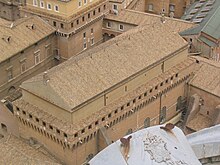
Back المجمع المغلق Arabic Konklav Azerbaijani Канклаў Byelorussian Канкляў BE-X-OLD Конклав Bulgarian Konklav Breton Conclave Catalan Konkláve Czech Konklave Danish Papstwahl German
 |
| This article is part of a series on |
| Vatican City |
|---|

A papal conclave is a gathering of the College of Cardinals convened to elect a bishop of Rome, also known as the pope. Catholics consider the pope to be the apostolic successor of Saint Peter and the earthly head of the Catholic Church.[1]
Concerns around political interference led to reforms after the interregnum of 1268–1271 and Pope Gregory X's decree during the Second Council of Lyons in 1274 that the cardinal electors should be locked in seclusion cum clave (Latin for "with a key") and not permitted to leave until a new pope had been elected.[2] Conclaves are now held in the Sistine Chapel of the Apostolic Palace in Vatican City.[3]
Since the Apostolic Age, the bishop of Rome, like other bishops, has been chosen by the consensus of the clergy and laity of the diocese.[4] The body of electors was more precisely defined when, in 1059, the College of Cardinals was designated the sole body of electors.[5] Since then, other details of the process have developed. In 1970, Pope Paul VI limited the electors to cardinals under 80 years of age in Ingravescentem aetatem. The current[update] procedures were established by Pope John Paul II in his apostolic constitution, Universi Dominici gregis,[3] as amended by Pope Benedict XVI in 2007 and 2013.[6] A two-thirds supermajority vote is required to elect the new pope.[7][8] The most recent papal conclave occurred in 2013, when Jorge Mario Bergoglio was elected as Pope Francis, succeeding the retiring Pope Benedict XVI.
- ^ Fanning, William H. W. (1913). . In Herbermann, Charles (ed.). Catholic Encyclopedia. New York: Robert Appleton Company.
- ^ Goyau, Georges (1913). . In Herbermann, Charles (ed.). Catholic Encyclopedia. New York: Robert Appleton Company.
- ^ a b John Paul II (22 February 1996). Universi Dominici gregis Archived 6 May 2007 at the Wayback Machine. Apostolic constitution. Vatican City: Vatican Publishing House.
- ^ Baumgartner 2003, p. 4.
- ^ Weber, N. A. (1913). . In Herbermann, Charles (ed.). Catholic Encyclopedia. New York: Robert Appleton Company.
- ^ "Pope Issues Conclave Motu Proprio" Archived 13 December 2017 at the Wayback Machine National Catholic Register. 25 February 2013.
- ^ Benedict XVI (11 June 2007). De aliquibus mutationibus in normis de electione Romani Pontificis Archived 22 December 2017 at the Wayback Machine (in Latin). Motu proprio. Vatican City: Vatican Publishing House.
- ^ "Pope alters voting for successor" Archived 14 September 2007 at the Wayback Machine. BBC News. 26 June 2007.
© MMXXIII Rich X Search. We shall prevail. All rights reserved. Rich X Search